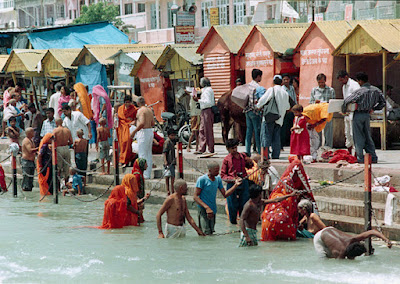Saturday, 28 July 2007
INDIA
Jamyang Choling
The Jamyang Choling Institute is a school of Buddhist character, located at the foothills of the Himalaya in India, that is part of an organisation of education for women from the most remotes areas of the mountain range.Founded by an American woman, the organisation has several schools spilt over the whole North of India, some in places of very difficult access, and completely isolated from the rest of the world during the winter.
Many of the students and teachers are exiled originating from Tibet, actually occupied by China. This is the Dharamshala branch, more precisely from Odder, 7 km futher down, situated in an area of great natural beauty, and that counted around forty pupils. I've been six months living in the Institute teaching English, and with other Tibetan Grammar and Philosophy teachers. I have watched the regular day of a community, subject to numerous problems, mutilated in its flesh and exiled in a country that does not belong to them.
The fact of living from donations, and so the lack of everything necessary to education, like books, rooms, blackboards, among other things, arises lots of physical and material problems, but also of communication because of the Tibetan language. With perseverance and a loads of work, I've managed to arrive at a sketch of some result, unfortunately because of the short sojourn of the voluntary teachers, many things should be started off anew, being the bases too fragile to hold a fruitful result.
More could be done, with more time and more means, but even though despite all the difficulties, the result is always positive. To the occasional interested, I've placed the link to the site of Jamyang Choling.
sutras

Sutras. The religious writings in Tibetan language. Volumes of texts that continue to be a theme of debate, study and worship by all the Buddhist society.
three o'clock tea

Around three o'clock, some students brought the "sweet" Indian tea, in contrast with the salty Tibetan tea, made of yak milk and butter, a delicacy for western tastes.
exams

When I arrived, in October, the philosophy exams were going in full swing. To the effect, they have raised a big tent with Tibetan patterns, and were carried in open air in the cool ambiance of the end of the Summer. They consist in writing exams about the Buddhist Mahayana Paramita philosophy proper of Tibet, Mongolia, Nepal and North India, and consist also in oral exams, the famous Buddhists debates in which are used all a symbology of gestures and movements relatively violent that are supposed to break and open the doors of the darkest hells and scare the numerous daemons of the Tibetan pantheon.
the old building

The old building where was the kitchen, some of the rooms of the students and also a little room for the telephone. The roof was a disgrace, said they, you could ear the rats during the night, but the worse were the snakes; to find a venomous reptil among the high herbs of the garden was one of the biggest fears of the nuns.
Once appeared, God knows where from, a snake charmer, he was selling medecins and several amulets for various ills. The little friend that came out the basket, when he started to call, was no more than a royal cobra, of the more dangerous that can be, that raises and fixes with a blank expression, a real fascination.
sutras

I've put the sutras out in the sun on the veranda, wrapped around in fabrics of gold and carmine, the winds took care to disperse them at the four cardinal points, as the words of the prayer flags.
lama

The director of the institution, one of the lamas of the highest grade, and of extreme sympathy, here at the oral auditions
lama teacher

The first teacher of philosophy who when I arrived, was there. He would came to reveal a personality with strong powers, he and the main nun were capable of rare actions, aren't we not dealing with Tibetan Buddhism...
the assembly

The assembly in half moon after meeting under the trees of big leaves.
the middle way

One of the biggest problems I've had with my students, some of them from the remotest and poorest places of the Himalayas, was related with our modern society, the western's XXIst century that nothing has to do with a mentality peopled with magic beings and mischievous spirits. I had a lot of problems in explaining what was a traffic light, for example, which was not obvious deep in the Indian jungle.
I've also created an incident when I referred to the fact that the Himalayas "grew" a bit more every year. Being stone inorganic, so not alive how could it grow. I've raised violent protests in the room, the problem was with magma and volcano's. What are volcano's? Once more the lack of information was causing big problems. I think that the power of the Buddha gave a little help to the matter. We have come to a concensus, I've almost been lynched for that one.

The tenwa of 108 elements.













































